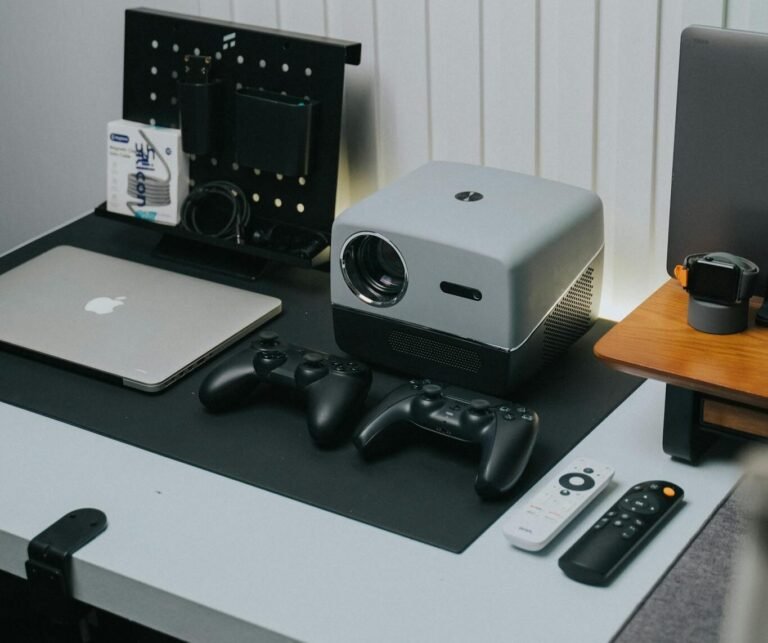
(Affiliate Disclosure: This post contains affiliate links. If you purchase through these links, we may earn a small commission at no extra cost to you. Thank you for your support!)
Understanding Projector Image Blurriness
Projector image blurriness can be a frustrating issue, significantly diminishing the viewing experience. Various factors contribute to a projector displaying a blurry image, and understanding these causes is essential for effective resolution.
Common Causes of a Blurry Projector Image
One of the primary reasons for a blurry portable projector is an incorrect focus setting. Many projectors come equipped with a focus adjustment feature, allowing users to fine-tune the clarity of the image displayed. If the projector is out of focus, the result is an indistinct picture that fails to deliver the intended sharpness.
Related posts: Mini Projector vs Portable Projector: A Detailed Comparison
Another common cause of blur is the distance between the projector and the screen. Each projector has a specified optimal throw distance, which varies depending on the model and lens type. If the projector is positioned too far or too close to the screen, the resulting image can appear unfocused. Therefore, evaluating the setup and ensuring that the projector is strategically placed at an appropriate distance is crucial for achieving a clear image.
Environmental factors also play a significant role in the clarity of a projected image. For instance, excess ambient light can wash out the projected image, making it appear blurry or faded. Additionally, if the projection surface is uneven or highly reflective (e.g., a textured wall or glossy board), it can contribute to distortion and the perception of a blurry image. We highly recommend using a flat, smooth, matte projector screen for the best results.
Related posts: Mini Projector Brightness Guide: How Many Lumens Do You Need?
Regular maintenance should also not be overlooked; for example, cleaning the projector lens is vital as dirt or smudges can obscure the light projection, leading to a blurred image.
Related posts: Troubleshooting Mini Projector Problems: Your Comprehensive Guide to Quick Fixes.
In addressing the question of why is my projector blurry, it becomes evident that multiple factors must be considered. Properly adjusting the projector focus, ensuring correct distance, maintaining a clean lens, and optimizing environmental factors are essential steps in enhancing image clarity. Understanding these aspects prepares users for effective troubleshooting and helps ensure an optimal viewing experience.
Quick Troubleshooting Guide: Blurry Projector Fixes
Here’s a concise summary of common causes and their immediate solutions for a blurry projector image:
| Problem Cause | How to Identify | Solution |
|---|---|---|
| Incorrect Focus Setting | The image is too large/small for the screen or is blurry at the edges. | Adjust the projector’s focus ring. |
| Incorrect Throw Distance | Gently clean the lens with proper tools. | Move the projector closer/farther from the screen. |
| Dirty Projector Lens | Smudges, spots, or overall dullness/haze. | Parts of the image are clear, others distorted/blurred. |
| Resolution Mismatch | Text looks blocky, distorted, or stretched. | Darken the room (e.g., blackout curtains) or use a higher lumen projector. |
| Excess Ambient Light | Image appears washed out, faded, lacking contrast. | Match the source device resolution to the projector’s native resolution. |
| Uneven/Poor Surface | Parts of the image are clear, others are distorted/blurred. | Project onto a flat, smooth, matte projector screen. |
Adjusting Focus Rings and Distance
When dealing with a blurry projector image, one of the first and simplest steps to consider is adjusting the focus rings on the device.
Fine-Tuning Your Projector’s Focus
Most projectors come equipped with focus lenses, which are essential for achieving a sharp image. To begin, locate the focus wheel or ring on your projector, typically found near the lens. Slowly turn the focus ring while observing the projected image; make incremental adjustments until the sharpness levels meet your requirements. This simple yet crucial step can often resolve issues related to projectors that appear out of focus.
Optimizing Throw Distance & Screen Size
In conjunction with adjusting the focus, the distance between the projector and the screen plays a vital role in image clarity. Projectors have a specified throw distance. What is the optimal distance for projecting a clear image on a screen? Generally, this distance can be found in the user manual or on the manufacturer’s website. To prevent a blurry portable projector experience, it is critical to position the projector within this specified range. If the projector is placed too close or too far, the resultant image is likely to be out of focus or too large, translating to an undesirable viewing experience.
Related posts: Portable Projector Buying Guide: What to Look for.
Additionally, consider how screen size influences focus. A larger screen may require more precise adjustments to focus settings, as the margins for error become smaller with increased size. When projecting onto a larger surface, ensure that the focus is carefully calibrated to maintain clarity throughout the projected image.
Related posts: The Ultimate Guide to Setting Up Your Outdoor Projector Screen
Cleaning the Lens: A Step-by-Step Guide.
Maintaining a clear and focused image is crucial for optimal projector performance. One of the most common reasons for a projector being out of focus is a dirty lens. Accumulated dust, fingerprints, and smudges can significantly distort the projected image, making it appear blurry. Therefore, it is essential to periodically clean the projector lens to ensure that it delivers a sharp, vibrant picture consistently.
Why a Clean Lens Matters
A clean lens is pivotal in avoiding a blurry projector image and enhances overall performance. Dust or grime can act as a barrier, scattering light and preventing the sharp projection you desire.
To effectively clean your projector lens, follow these steps:
- Gather Materials: You will need a soft, microfiber cloth, lens cleaning solution specifically designed for optics, and a can of compressed air. Avoid using paper towels or household cleaners, as these can scratch or damage the lens coating.
- Turn Off and Unplug the Projector: Before cleaning, ensure the projector is turned off and unplugged. Allow it to cool down, as the lens can become very hot during operation.
- Use Compressed Air: Start by using the can of compressed air to gently blow away any loose dust or debris on the lens surface. Hold the can upright and maintain a distance of a few inches to prevent moisture from being dispensed.
- Apply Cleaning Solution: Dampen a corner of the microfiber cloth with the lens cleaning solution. Ensure that the cloth is not dripping wet, as excess liquid can seep into the projector and cause damage.
- Wipe the Lens: Using the dampened cloth, gently wipe the lens in a circular motion, starting from the center and moving outwards. This technique helps to lift any remaining dirt or smudges without scratching the surface.
- Inspect the Lens: After cleaning, inspect the lens from different angles to ensure no residue remains. A clear lens is essential for fixing a blurry projector image.
Understanding why your projector is blurry due to a dirty lens and knowing how to clean it properly can prevent future focus issues. Regular maintenance, such as cleaning projector lenses, can significantly enhance the overall quality of the projected image.
- The full-frame sensor cleaning swab is compatible with all full-frame camera sensors. The extremely soft and flexible sw…
- The non-alcoholic and ammonia-free lens and sensor cleaner has a non-aggressive formula. It is safe for both COMS and CC…
- The microfiber lens cleaning cloth is made of special ultra-micro fiber which has excellent absorbent features. It can e…
Checking Resolution Settings and Compatibility.
One of the primary reasons for a blurry projector image is the mismatch between the projector’s resolution settings and the resolution of the source device. When a projector is out of focus due to improper resolution settings, users may inadvertently question why their projector appears blurry. Adjusting the projector focus alone may not resolve the issue if the resolution settings are misconfigured.
Matching Native Resolution
To begin with, it is essential to check the output resolution of your source device—be it a laptop, computer, or other multimedia devices. Most projectors will perform optimally when the input resolution matches their native resolution. This means that if you are using a blurry portable projector, ensure that the source device’s resolution aligns with what the projector supports. Many projectors have a native resolution with a specific set of formats (e.g., 1920×1080 for HD projectors), while others may support various resolutions but may not display optimally at all of them. Testing with different resolutions can help identify the correct setting that produces a clearer image.
Related posts: Portable Projector Buying Guide: What to Look for.
Source Device & Cable Configuration
Furthermore, many operating systems allow users to adjust their display settings easily. On Windows, users can access “Display Settings” and modify the resolution accordingly. Similarly, Mac users can go to “System Preferences” and select the appropriate resolution under “Displays.” For devices that use HDMI, ensure that the HDMI output settings are compatible with the projector’s capabilities. In some cases, the cable or adapter used may also play a role, so ensuring they support the required resolution is critical.
Related posts: Portable Projector Connectivity Guide: HDMI, USB, Wi-Fi, Bluetooth.
If the settings seem correct but the image remains blurry, cleaning the projector lens is always a good next step. Dust or smudges can further aggravate an already poor image quality. By adjusting the projector focus and setting the correct resolution, users can significantly enhance their viewing experience. In conclusion, addressing resolution settings and ensuring compatibility between devices are crucial steps in fixing a blurry projector image.
Key Takeaways for a Crystal-Clear Projector Image.
To ensure your projector always delivers its best, remember these essential steps:
- Adjust Focus: Always start by turning the focus ring.
- Check Distance: Position your projector within its optimal throw distance.
- Clean Lens: Periodically clean your projector lens with appropriate tools.
- Match Resolution: Ensure your source device’s output resolution matches your projector’s native resolution.
- Control Environment: Minimize ambient light and use a flat, suitable projection surface.
- Note: 1/4in (6.35mm) Mounting Screw Thread
- Ultra-Compact and Portable: Weighs only 376 g, with a diameter of just 150 mm, and a thickness of 35 mm when folded, mak…
- Effortless Installation: In just a few seconds, you can easily set up your D1 projector on the portable stand, adjust it…
Frequently Asked Questions (FAQ)
Q: Why is my projector image blurry all of a sudden?
A: If your projector image suddenly becomes blurry, the most common culprits are: the focus ring was accidentally bumped, the projector or screen moved, or the lens has collected dust or smudges. Start by re-adjusting the focus and checking the lens.
Q: Can I fix a blurry image without moving the projector?
A: Yes, often! First, try adjusting the focus ring on the projector lens. If that doesn’t work, check your source device’s display resolution settings to ensure they match your projector’s native resolution. Cleaning the lens is also a key step that doesn’t require moving the projector.
Q: What’s the best way to clean a projector lens?
A: The best way to clean a projector lens is with a soft microfiber cloth, a lens cleaning solution specifically designed for optics, and compressed air. Always blow off loose dust first with compressed air, then gently wipe with the dampened cloth in a circular motion. Avoid harsh chemicals or abrasive materials.
Q: What resolution should my projector be set to for the clearest picture?
A: For the clearest picture, your source device’s output resolution should match your projector’s native resolution. For example, if you have a projector with a native 1920×1080 (Full HD) resolution, set your laptop or streaming device to 1920×1080. Using a resolution higher or lower than the native one can cause blurriness or pixelation.
Related posts: Portable Projector Buying Guide: What to Look for.
Q: Can a bad HDMI cable cause a blurry image?
A: Yes, a faulty or incompatible HDMI cable can definitely cause a blurry, distorted, or even flickering image. Ensure you are using a high-quality, properly connected HDMI cable that supports the resolution you are trying to display.
Related posts: Portable Projector Connectivity Guide: HDMI, USB, Wi-Fi, Bluetooth.
Q: Why does my projector get blurry after a while (overheating)?
A: If your projector starts sharply but gets blurry after a period of use, it might be due to overheating. Heat can cause internal components to expand, slightly shifting the lens elements and leading to blur. Ensure your projector has adequate ventilation and its vents are not blocked.
Related posts: Understanding Projector Overheating: Causes and Solutions.




